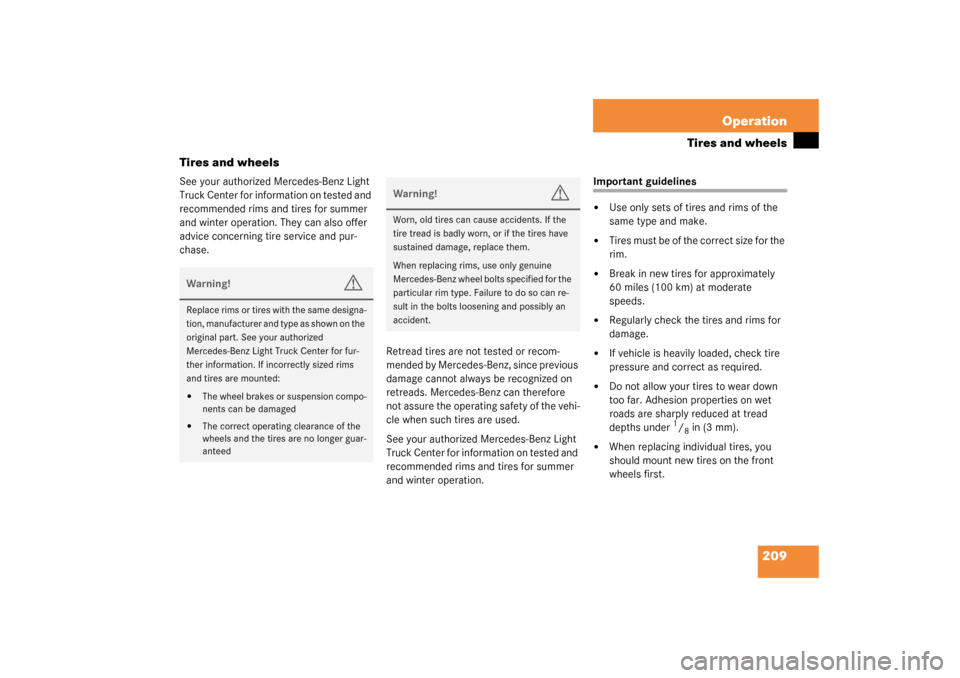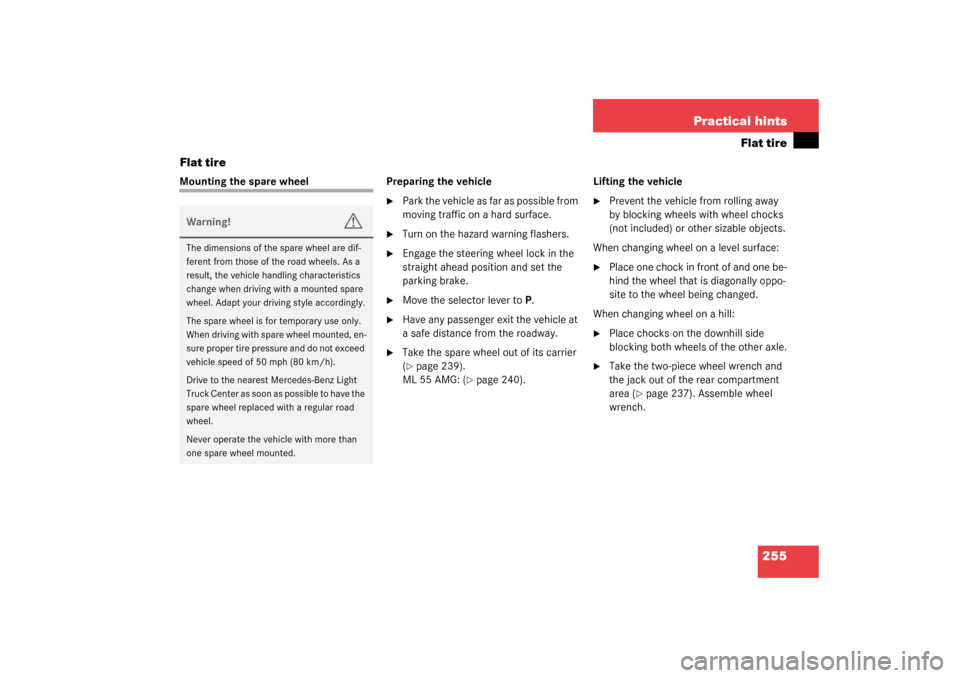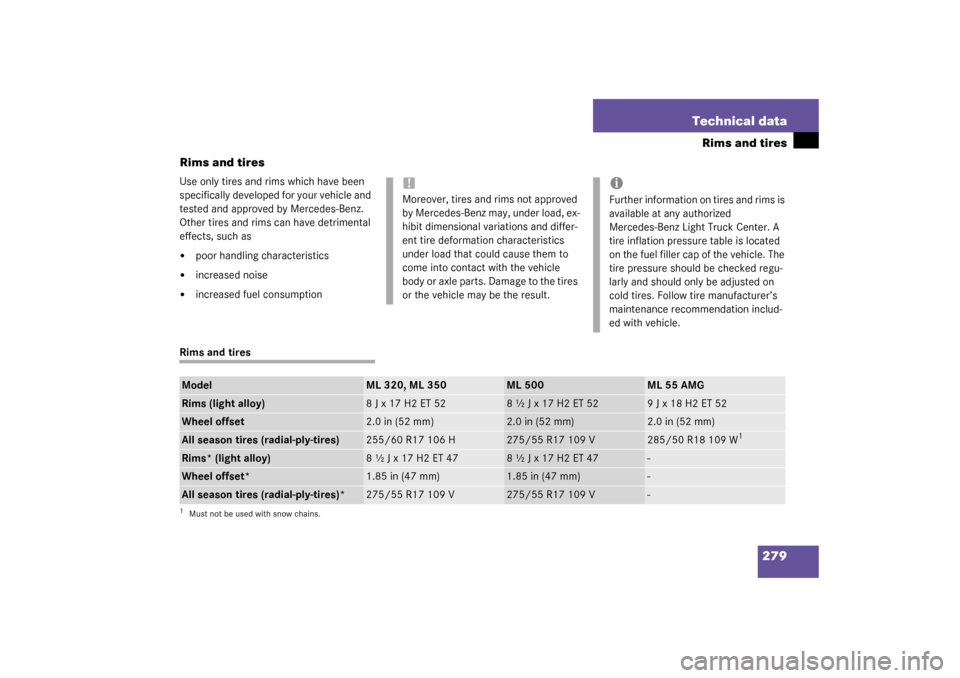Page 209 of 321

209 Operation
Tires and wheels
Tires and wheels
See your authorized Mercedes-Benz Light
Truck Center for information on tested and
recommended rims and tires for summer
and winter operation. They can also offer
advice concerning tire service and pur-
chase.
Retread tires are not tested or recom-
mended by Mercedes-Benz, since previous
damage cannot always be recognized on
retreads. Mercedes-Benz can therefore
not assure the operating safety of the vehi-
cle when such tires are used.
See your authorized Mercedes-Benz Light
Truck Center for information on tested and
recommended rims and tires for summer
and winter operation.
Important guidelines�
Use only sets of tires and rims of the
same type and make.
�
Tires must be of the correct size for the
rim.
�
Break in new tires for approximately
60 miles (100 km) at moderate
speeds.
�
Regularly check the tires and rims for
damage.
�
If vehicle is heavily loaded, check tire
pressure and correct as required.
�
Do not allow your tires to wear down
too far. Adhesion properties on wet
roads are sharply reduced at tread
depths under
1/8in (3 mm).
�
When replacing individual tires, you
should mount new tires on the front
wheels first.
Warning!
G
Replace rims or tires with the same designa-
tion, manufacturer and type as shown on the
original part. See your authorized
Mercedes-Benz Light Truck Center for fur-
ther information. If incorrectly sized rims
and tires are mounted:�
The wheel brakes or suspension compo-
nents can be damaged
�
The correct operating clearance of the
wheels and the tires are no longer guar-
anteed
Warning!
G
Worn, old tires can cause accidents. If the
tire tread is badly worn, or if the tires have
sustained damage, replace them.
When replacing rims, use only genuine
Mercedes-Benz wheel bolts specified for the
particular rim type. Failure to do so can re-
sult in the bolts loosening and possibly an
accident.
Page 210 of 321
210 OperationTires and wheels
Life of tire
The service life of a tire is dependent upon
varying factors including but not limited to:�
Driving style
�
Tire pressure
�
Distance driven
Direction of rotation
Unidirectional tires offer added advantag-
es, such as better hydroplaning perfor-
mance. To benefit, however, you must
ensure that the tires rotate in the direction
specified.
An arrow on the sidewall indicates the in-
tended direction of rotation of the tire.
!When the wheels are heavily soiled,
e.g. after driving through mud, clean
the inside of the wheels with a jet of
water.
Warning!
G
Tires and spare tire should be replaced after
six years, regardless of the remaining tread.!Keep unmounted tires in a cool, dry
place with as little exposure to light as
possible. Protect tires from contact
with oil, grease and gasoline.
Page 211 of 321

211 Operation
Tires and wheels
Checking tire inflation pressure
Correct the tire pressure only when tires
are cold.
Regularly check your tire pressure at inter-
vals of no more than 14 days.
If the tires are warm, you should only cor-
rect the tire pressure if it is too low for cur-
rent operating conditions.
A table on the fuel filler flap lists the spec-
ified tire inflation pressures for warm and
cold tires as well as for various operating
conditions.Tire pressure changes by approximately
1.5 psi (0.1 bar) per 18°F (10°C) of air
temperature change. Keep this in mind
when checking tire pressure where the
temperature is different from the outside
temperature.
Tire temperature and tire pressure are also
increased while driving, depending on the
driving speed and the tire load.Check the spare tire periodically for condi-
tion and inflation. Spare tire will age and
b e c o m e w o r n o v e r t i m e e v e n i f n e v e r u s e d ,
and thus should be inspected and replaced
when necessary.Warning!
G
If the tire pressure repeatedly drops:�
Check the tires for punctures from for-
eign objects
�
Check to see whether air is leaking from
the valves or from around the rim
iThe pressures listed for light loads are
minimum values offering high driving
comfort.
Increased inflation pressures listed for
heavier loads may also be used for light
loads. These higher pressures produce
favorable handling characteristics. The
ride of the vehicle, however, will be
somewhat harder. Never exceed the
max. values or inflate tires below the
min. values listed in the fuel filler flap.
Warning!
G
Follow recommended inflation pressures.
Do not overinflate tires. Overinflated tires
can result in sudden deflation (blowout) be-
cause they are more likely to become punc-
tured or damaged by road debris, potholes
etc.
Do not underinflate tires. Underinflated tires
wear unevenly, adversely affect handling
and fuel economy, and are more likely to fail
from being overheated.
Do not overload the tires by exceeding the
specified vehicle capacity weight (as indicat-
ed by the label on the pillar in the driver’s
door opening). Overloading the tires can
overheat them, possibly causing a blowout.
Page 212 of 321
212 OperationTires and wheelsRotating wheels
The wheels can be rotated every 3000 to
6000 miles (5 000 to 10 000 km) or sooner
if necessary, according to the degree of
tire wear. The same direction of tire rota-
tion must be retained.
Rotate the wheels before the characteris-
tic tire wear pattern becomes visible
(shoulder wear on front wheels and tread
center wear on rear wheels).
Thoroughly clean the inner side of the
wheels after each rotation. Check and en-
sure proper tire inflation pressure.Information on changing a wheel can be
found in the “Practical hints” section
(
�page 255).
Warning!
G
Rotate front and rear wheels only if they are
of the same size,
Warning!
G
Have the tightening torque checked after
changing a wheel. Wheels could become
loose if not tightened with a torque of
110 ft.lb. (150 Nm).
Use only genuine Mercedes-Benz wheel
bolts specified for your vehicle's rims.
Page 255 of 321

255 Practical hints
Flat tire
Flat tire
Mounting the spare wheel Preparing the vehicle
�
Park the vehicle as far as possible from
moving traffic on a hard surface.
�
Turn on the hazard warning flashers.
�
Engage the steering wheel lock in the
straight ahead position and set the
parking brake.
�
Move the selector lever toP.
�
Have any passenger exit the vehicle at
a safe distance from the roadway.
�
Take the spare wheel out of its carrier
(�page 239).
ML 55 AMG: (
�page 240).Lifting the vehicle
�
Prevent the vehicle from rolling away
by blocking wheels with wheel chocks
(not included) or other sizable objects.
When changing wheel on a level surface:
�
Place one chock in front of and one be-
hind the wheel that is diagonally oppo-
site to the wheel being changed.
When changing wheel on a hill:
�
Place chocks on the downhill side
blocking both wheels of the other axle.
�
Take the two-piece wheel wrench and
the jack out of the rear compartment
area (
�page 237). Assemble wheel
wrench.
Warning!
G
The dimensions of the spare wheel are dif-
ferent from those of the road wheels. As a
result, the vehicle handling characteristics
change when driving with a mounted spare
wheel. Adapt your driving style accordingly.
The spare wheel is for temporary use only.
When driving with spare wheel mounted, en-
sure proper tire pressure and do not exceed
vehicle speed of 50 mph (80 km/h).
Drive to the nearest Mercedes-Benz Light
Truck Center as soon as possible to have the
spare wheel replaced with a regular road
wheel.
Never operate the vehicle with more than
one spare wheel mounted.
Page 259 of 321

259 Practical hints
Flat tire
Inflating the spare wheel with
collapsible tire�
Take the electric air pump out of the
rear cargo compartment (
�page 238).
1Union nut
2Electrical plug
3Air hose with pressure gauge
4Vent screw
�
Open flap on air pump.
�
Pull out electrical plug2 and air hose
with the pressure gauge3.
�
Close the vent screw4.
�
Remove the valve cap from the spare
wheel tire valve.
�
Screw the union nut1 with air hose3
on to the tire valve.
�
Insert electrical plug 2 into the electri-
cal outlet in the front passenger foot-
well or rear cargo compartment
(�page 158).
�
Start the engine.
�
Switch on the air pump.
�
Operate air pump until the pressure
gauge displays 61 psi (4.2 bar)
This takes about eight minutes for the
collapsible tire. The air hose 3 and the
union nut 1 can become hot during in-
flation. Please exercise appropriate
caution.
�
Switch off the air pump.
�
Turn off the engine.
�
If the tire pressure is above 61 psi
(4.2 bar), release excess tire pressure
using the vent screw4.
Warning!
G
Observe instructions on air pump label.
!Do not operate the electric air pump
longer than eight minutes without in-
terruption. Otherwise it may overheat.
You may operate the air pump again af-
ter it has cooled off.
Page 260 of 321
260 Practical hintsFlat tire
�
Detach the electric air pump.
�
Reinstall tire valve cap.
�
Store the electrical plug and the air
hose behind the flap and place the air
pump back in the rear cargo compart-
ment.
Warning!
G
Follow recommended inflation pressures.
Do not overinflate tires. Overinflated tires
can result in sudden deflation (blowout) be-
cause they are more likely to become punc-
tured or damaged by road debris, potholes
etc.
Do not underinflate tires. Underinflated tires
wear unevenly, adversely affect handling
and fuel economy, and are more likely to fail
from being overheated.
Do not overload the tires by exceeding the
specified vehicle capacity weight (as indicat-
ed by the label on the driver’s door latch
post). Overloading the tires can overheat
them, possibly causing a blowout.
Page 279 of 321

279 Technical data
Rims and tires
Rims and tires
Use only tires and rims which have been
specifically developed for your vehicle and
tested and approved by Mercedes-Benz.
Other tires and rims can have detrimental
effects, such as�
poor handling characteristics
�
increased noise
�
increased fuel consumption
Rims and tires
!Moreover, tires and rims not approved
by Mercedes-Benz may, under load, ex-
hibit dimensional variations and differ-
ent tire deformation characteristics
under load that could cause them to
come into contact with the vehicle
body or axle parts. Damage to the tires
or the vehicle may be the result.
iFurther information on tires and rims is
available at any authorized
Mercedes-Benz Light Truck Center. A
tire inflation pressure table is located
on the fuel filler cap of the vehicle. The
tire pressure should be checked regu-
larly and should only be adjusted on
cold tires. Follow tire manufacturer’s
maintenance recommendation includ-
ed with vehicle.
Model
ML 320, ML 350
ML 500
ML 55 AMG
Rims (light alloy)
8 J x 17 H2 ET 52
8 ½ J x 17 H2 ET 52
9 J x 18 H2 ET 52
Wheel offset
2.0 in (52 mm)
2.0 in (52 mm)
2.0 in (52 mm)
All season tires (radial-ply-tires)
255/60 R17 106 H
275/55 R17 109 V
285/50 R18 109 W
1
1Must not be used with snow chains.Rims* (light alloy)
8 ½ J x 17 H2 ET 47
8 ½ J x 17 H2 ET 47
-
Wheel offset*
1.85 in (47 mm)
1.85 in (47 mm)
-
All season tires (radial-ply-tires)*
275/55 R17 109 V
275/55 R17 109 V
-